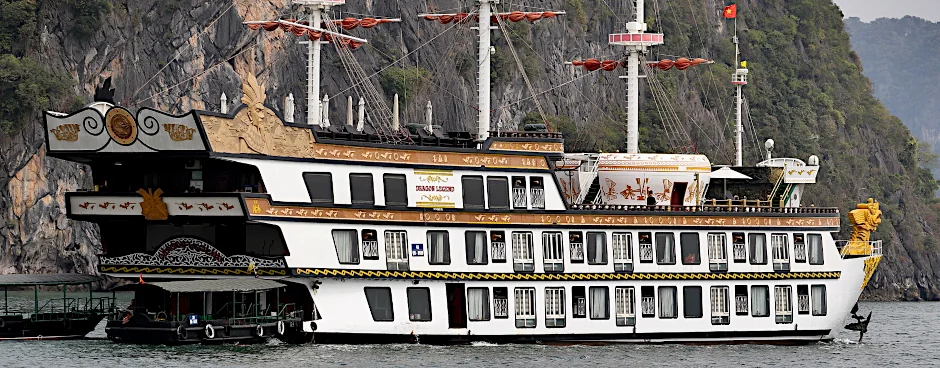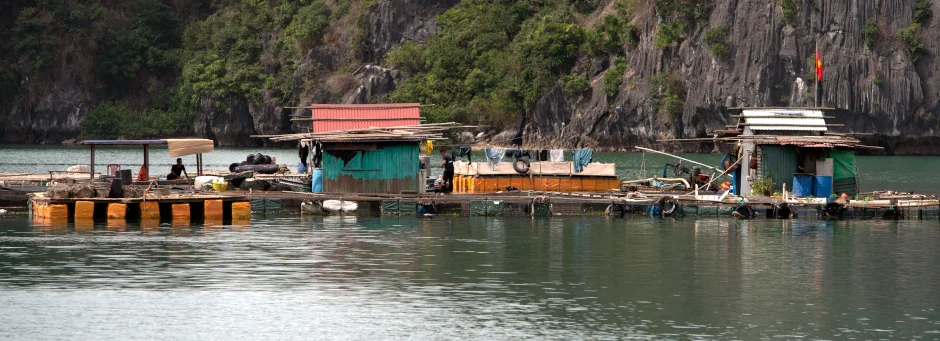Guest Article: Cruising Halong Bay, Vietnam
Story and photography by Simon Goodinson* and Ray Waddington.
*Simon Goodinson is a travel photographer based in the United Kingdom.
Click/tap an image to begin a captioned slideshow (best viewed on a modern, wide-gamut display) and stock licensing details.
Watch our short documentary film Cruising Halong Bay, Vietnam on YouTube.
Most of the world is covered by water. For that reason alone we might expect that a significant proportion of its eight billion inhabitants would live on water. Yet the opposite is the case. A well-known exception is Inle Lake in Shan State, Burma (Myanmar), where many indigenous Intha people live. A second is Halong Bay — a region with thousands of islands and islets off the northern Vietnamese coast.
Forged over hundreds of millions of years by various geological processes, the Bay's mythological creation story is far more interesting than the scientific account. Local legend has it that the indigenous people were about to lose their land and livelihood at the hands of aggressive invaders. They called upon the great Mother Dragon and her children to protect them. Their call was answered and the enemy defeated. Then the dragons decided to remain and live in the area to guard the people from any future invaders. They made the islands as a barrier to prevent any further attacks.
Mythology aside, Halong Bay (the place where dragons come down in Vietnamese) has been recognized as a UNESCO World Heritage Site for almost 30 years. Best visited on a tour of at least three days, even a few hours on the bay will demonstrate why. There really is no other place like it in the world. Perhaps that's why it was chosen as a location for many films including Kong: Skull Island
Few people actually live on the water close to the mainland. But a short tour won't take you very far offshore. You'll see locals fishing and you may see some cargo boats. But mostly you'll see boats and cruise ships carrying tourists. And, of course, you'll see some stunning scenery. Kayaking for an hour or two around a few islands is a great way to see them close up. Then an abundance of fresh seafood will keep you going until you return to the mainland or, even better, spend a tranquil night being rocked to sleep by the bay's gentle waves.
Day two is the highlight of the 3-day Halong Bay tour that we took. Most of these tours bring you to Cat Ba Island and take about ten hours to reach it. As you sail south the amount of human activity on the bay increases until you realize that the whole area is one big floating economy. Here the locals outnumber the tourists. Fishing, trawling and trapping are the main livelihoods, but with so many people making their living that way ancillary industries are also present.
As you sail closer to what looks like it should be the domain of a hermit, you'll see the same kind of activity that keeps any micro economy afloat. One floating house might be a restaurant, another a hardware/repair store. A third will be a fueling station for the motor-powered boats that ply this part of the bay. Some will be a combination of these. They are also mostly the permanent homes of those who own or run these businesses. A few even offer rooms for the night.
The better Halong Bay tours will call in to one of these places for an hour or so even if they don't need to. It's not only a good way to break up the journey (a kind of maritime stopover), it's also a great opportunity to relax and observe the comings and goings of the local economy and to capture photographs of it.
The area is served these days by an extensive cellular tower network. So you'll be able to post your selfies or even livestream to social media. But it wasn't always like this. One of us had visited the bay twenty years ago. The only Internet access back then was through dedicated Internet cafes on the mainland; very few people in Vietnam had a mobile phone.
We have to go back thousands of years, though, to get a picture of what life was like for the earliest settlers. We know from archaeological findings that people were eating the bay's fish and seafood at least 7,000 years ago. Beginning around 5,000 years ago some of the islands had permanent or semi-permanent, small populations. (Even today less than fifty islands are populated.) Their ability to survive had been enhanced by advanced boat building and making simple fishing nets. That was the turning point in the bay's history, and once surplus replaced subsistence trade routes developed and this attracted more settlers.
Thus we see an example of how indigenous knowledge has been paramount to the successful colonization of the whole planet. In one sense the indigenous settlers of Halong Bay were actually too successful. Today the Vietnamese government considers the area too populated for its long-term sustainability. A few years ago it began forcibly re-populating people to the mainland. It allows a quota to remain — but mainly to support and encourage tourism.
By late afternoon you are just a few kilometers from Cat Ba Island. But there is one more surprise in store before you regain your land legs. There are a few floating villages around the island. But the one you're likely to sail through in the final stretch of your second day is by far the biggest. In fact it must be one of the largest floating villages in the world.
You won't only see floating houses here. The village is a community in every sense of the word. Floating supermarkets are everywhere as well as many other kinds of shops and restaurants; in short everything a community needs for day-to-day living. Chances are you've never seen a village quite like it.
Soon you'll arrive on Cat Ba Island. Pay close attention on the way to your lodging. You'll get a good sense of just how much of the island's commerce takes place on the water. Finally, here's a photography tip. Try to get a room at one of the more modern hotels on a high floor with a view facing west over the bay. That is as good a location as any to get your iconic Vietnam photo.
Early the next morning you're en route for about six hours through yet more stunning scenery until you dock back at the mainland. The kind of tour we took is, perhaps, the most convenient and popular way to visit Halong Bay. But it is far from the only way. On a tour like this you'll see very little of Cat Ba Island itself. It is by far the most populated of the islands and can easily keep you busy for a few days. Then you have the possibility of spending a night or two in a floating house. An intrepid traveler could easily spend a whole week visiting Halong Bay.
Photography and text copyright © 1999 - 2025, Simon Goodinson and Ray Waddington. All rights reserved.
Goodinson, S., and Waddington, R., (2022) Cruising Halong Bay, Vietnam. The Peoples of the World Foundation. Retrieved
December 18, 2025,
from The Peoples of the World Foundation.
<https://www.peoplesoftheworld.org/guestArticle.jsp?article=halong%20bay>
If you enjoyed reading this article, please consider buying us a coffee to help us cover the cost of hosting our web site. Please click on the link or scan the QR code. Thanks!











